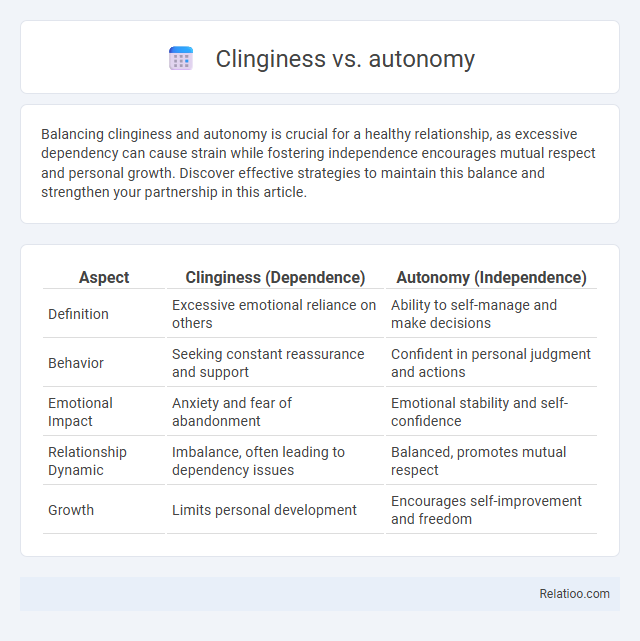Balancing clinginess and autonomy is crucial for a healthy relationship, as excessive dependency can cause strain while fostering independence encourages mutual respect and personal growth. Discover effective strategies to maintain this balance and strengthen your partnership in this article.
Table of Comparison
| Aspect | Clinginess (Dependence) | Autonomy (Independence) |
|---|---|---|
| Definition | Excessive emotional reliance on others | Ability to self-manage and make decisions |
| Behavior | Seeking constant reassurance and support | Confident in personal judgment and actions |
| Emotional Impact | Anxiety and fear of abandonment | Emotional stability and self-confidence |
| Relationship Dynamic | Imbalance, often leading to dependency issues | Balanced, promotes mutual respect |
| Growth | Limits personal development | Encourages self-improvement and freedom |
Understanding Clinginess and Autonomy
Understanding clinginess involves recognizing excessive dependence on others for emotional support, which can lead to suffocation in relationships. Autonomy, by contrast, emphasizes self-reliance and healthy boundaries that foster personal growth and balanced connections. Your ability to balance these dynamics is crucial for maintaining intimacy without emotional distance.
Psychological Roots of Clinginess
Clinginess often stems from deep-seated insecurities and attachment anxiety, where fear of abandonment drives excessive dependency in relationships. Your psychological roots of clinginess are linked to early relational experiences, such as inconsistent caregiving, which shape an individual's need for constant reassurance and proximity. Balancing autonomy and emotional distance requires understanding these underlying fears to foster healthier boundaries and emotional resilience.
The Importance of Personal Autonomy
Personal autonomy is essential for maintaining a healthy balance between closeness and individuality in relationships. Your ability to set boundaries fosters emotional resilience, reduces clinginess, and prevents harmful emotional distance. Prioritizing autonomy supports mutual respect, personal growth, and deeper emotional connections.
Signs of Unhealthy Attachment
Unhealthy attachment manifests through clinginess, characterized by excessive dependence and fear of abandonment that stifles personal growth and autonomy. Emotional distance emerges as a defense mechanism, causing detachment and a lack of genuine intimacy, disrupting healthy relationship dynamics. Key signs include constant need for reassurance, avoidance of vulnerability, and persistent anxiety over separation, indicating imbalanced attachment styles that hinder emotional well-being.
Balancing Emotional Needs in Relationships
Balancing emotional needs in relationships requires navigating clinginess, autonomy, and emotional distance to foster healthy connections. Excessive clinginess can lead to dependency and suffocation, while too much autonomy might cause emotional detachment and isolation. Establishing clear boundaries and open communication helps partners maintain closeness without compromising individual independence or fostering emotional distance.
Effects of Clinginess on Personal Growth
Clinginess can hinder your personal growth by creating dependency that limits self-exploration and decision-making autonomy. Excessive neediness often leads to emotional distance, straining relationships and impairing the development of healthy boundaries. Balancing independence with emotional connection fosters resilience and supports continuous personal development.
How Autonomy Enhances Relationship Quality
Autonomy in relationships fosters mutual respect and personal growth, leading to higher relationship satisfaction and emotional fulfillment. When partners maintain individual interests and boundaries, they reduce clinginess and prevent emotional distance, creating a healthy balance. This independence encourages better communication, trust, and intimacy, enhancing overall relationship quality.
Strategies to Overcome Clinginess
Overcoming clinginess involves cultivating personal interests and establishing clear boundaries to foster autonomy and reduce dependence on others. Developing self-awareness through mindfulness and reflective practices helps manage emotional needs without causing emotional distance in relationships. Strengthening communication skills allows individuals to express vulnerability constructively while maintaining healthy emotional connections.
Fostering Healthy Independence
Balancing clinginess, autonomy, and emotional distance is essential for fostering healthy independence in relationships. You can promote emotional growth by encouraging open communication and respecting personal boundaries while maintaining connection. Prioritizing self-awareness and mutual support helps build trust and a stronger bond without compromising individuality.
Building Trust for Mutual Autonomy
Balancing clinginess, autonomy, and emotional distance is essential for fostering mutual trust in relationships. You can build trust by respecting each other's need for independence while maintaining emotional connection through open communication and consistent support. Establishing clear boundaries allows both partners to feel secure and valued, promoting a healthy, mutually autonomous dynamic.

Infographic: Clinginess vs autonomy
 relatioo.com
relatioo.com